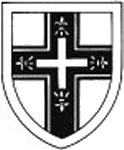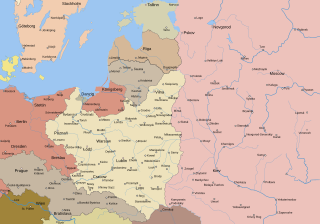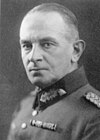
Army Group North was the name of three separate army groups of the Wehrmacht during World War II. Its rear area operations were organized by the Army Group North Rear Area.
Army Group Courland was a German Army Group on the Eastern Front. It was created from remnants of the Army Group North, isolated in the Courland Peninsula by the advancing Soviet Army forces during the 1944 Baltic Offensive of the Second World War. The army group remained isolated in the Courland Pocket until the end of World War II in Europe. All units of the Army Group were ordered to surrender by the capitulated Wehrmacht command on 8 May 1945.

The Battle of Narva was a World War II military campaign, lasting from 2 February to 10 August 1944, in which the German Army Detachment "Narwa" and the Soviet Leningrad Front fought for possession of the strategically important Narva Isthmus.

The Baltic offensive, also known as the Baltic strategic offensive, was the military campaign between the northern Fronts of the Red Army and the German Army Group North in the Baltic States during the autumn of 1944. The result of the series of battles was the isolation and encirclement of the Army Group North in the Courland Pocket and Soviet re-occupation of the Baltic States. In Soviet propaganda, this offensive was listed as one of Stalin's ten blows.

The military occupation of Latvia by Nazi Germany was completed on 10 July 1941, by Germany's armed forces. Initially, the territory of Latvia was under the military administration of Army Group North, but on 25 July 1941, Latvia was incorporated as Generalbezirk Lettland, subordinated to Reichskommissariat Ostland, an administrative subdivision of Nazi Germany. Anyone not racially acceptable or who opposed the German occupation, as well as those who had cooperated with the Soviet Union, was killed or sent to concentration camps in accordance with the Nazi Generalplan Ost.
Many Latvians resisted the occupation of Latvia by Nazi Germany. Independent Latvia had been occupied by the Soviet Union in June 1940, then by Nazi Germany in July 1941, forming Generalbezirk Lettland. The Latvian resistance movement was divided between the pro-independence units under the Latvian Central Council and the pro-Soviet units under the Central Staff of the Partisan Movement in Moscow. Daugavpils was the scene of fierce Jewish resistance during the Holocaust. Many local Latvians were actively involved in the resistance movement against the ethnic policies of the German occupation regime. 134 Latvians were later honored with the title Righteous Among the Nations, among them is Žanis Lipke, who risked his life to save more than 50 Jews.

After the occupation of Latvia by the USSR in June 1940, much of the previous Latvian army was disbanded and many of its soldiers and officers were arrested and imprisoned or executed. The following year Nazi Germany occupied Latvia during the offensive of Army Group North. The German Einsatzgruppen were aided by a group known as Arajs Kommando in the killing of Latvian Jews as part of the Holocaust. Latvian soldiers fought on both sides of the conflict against their will, and in 1943 180,000 Latvian men were drafted into the Latvian Legion of the Waffen-SS and other German auxiliary forces.

The Courland Pocket was an area of the Courland Peninsula where Army Group North of Nazi Germany and the Reichskommissariat Ostland were cut off and surrounded by the Red Army for almost a year, lasting from July 1944 until 10 May 1945.

The Leningrad Front was formed during the 1941 German approach on Leningrad by dividing the Northern Front into the Leningrad Front and Karelian Front on August 27, 1941.
Carl Hilpert was a German general during World War II.
The 1st Shock Army was a field army established by the Soviet Union's Red Army during World War II. The 1st Shock Army was created in late 1941 and fought in the northern areas of Russia and the Baltic States until the surrender of Germany in 1945. The Army was created in accordance with prewar doctrine that called for Shock Armies to 'overcome difficult defensive dispositions in order to create a tactical penetration of sufficient breadth and depth to permit the commitment of mobile formations for deeper exploitation.' However, as the war went on, Shock Armies lost this specific role and reverted, in general, to ordinary frontline formations.

The 51st Army was a field army of the Red Army that saw action against the Germans in World War II on both the southern and northern sectors of the front. The army participated in the Battle of the Kerch Peninsula between December 1941 and January 1942; it was destroyed in May 1942 with other Soviet forces when the Wehrmacht launched an operation to dislodge them from the peninsula. The army fought in the Battle of Stalingrad during the winter of 1942–43, helping to defeat German relief attempts. From late 1944 to the end of the war, the army fought in the final cutting-off of German forces in the Courland area next to the Baltic. Inactivated in 1945, the army was activated again in 1977 to secure Sakhalin and the Kuril Islands. Following the dissolution of the Soviet Union, the army continued in existence as a component of the Russian Ground Forces. The army was active during two periods from 1941 until 1997.

The 24th Infantry Division was a German Army infantry division active in World War II. It served across the Eastern Front in engagements such as the Sieges of Sevastopol and the Leningrad, finally being destroyed in the Courland Pocket in 1945.

The 205th Infantry Division was a German infantry division of the Heer during the Second World War. It was initially known as the 14th Landwehr Division.
The 67th Army was a field army of the Soviet Union's Red Army. The 67th Army was formed in October 1942 on the Leningrad Front from the Neva Operational Group. It defended the right bank of the Neva River, holding the Nevsky Pyatachok and covering the Road of Life. In January 1943 the army fought in Operation Iskra. In late December, the army was combined with 55th Army. The 67th Army headquarters was disbanded and 55th Army headquarters was renamed 67th Army headquarters. Between January and March 1944 67th Army fought in the Leningrad–Novgorod Offensive, in which it captured Mga and Luga. In April the army became part of the 3rd Baltic Front and fought in the Pskov-Ostrov Offensive in July and the Tartu Offensive in August and September. The army fought in the Riga Offensive in September and October. The army then fought to eliminate the Courland Pocket. After the end of the war the army was disbanded during the summer of 1945.
The 327th Rifle Division was first formed in September 1941, as a standard Red Army rifle division, based on a cadre of workers from Voronezh. This formation was assigned to the Volkhov Front near Leningrad, toiling through the so-called "Rat's War" in the wooded swamps of that region and taking significant casualties in the encirclement of its 2nd Shock Army near Lyuban in early 1942. In January 1943, it helped to lead the partial raising of the German siege of Leningrad in Operation Iskra, distinguishing itself sufficiently to be redesignated as the 64th Guards Rifle Division. Well over a year later a second 327th Rifle Division was formed and was also moved to the Leningrad region where it took part in the offensive that drove Finland from the war, then spent the first months of 1945 clearing German forces from the coasts of the Baltic States and containing the German forces trapped in Courland.
The 268th Rifle Division was an infantry division of the Soviet Union's Red Army during World War II.
X Army Corps was a corps in the German Army during World War II. It was formed in mid-May 1935 from the Cavalry Division.

The 377th Rifle Division was raised in 1941 as an infantry division of the Red Army, and served for the duration of the Great Patriotic War in that role. It began forming in August 1941 in the Urals Military District. It followed a very similar combat path to that of the 374th and 376th Rifle Divisions. It joined the fighting front in December with the 4th Army, and then briefly came under command of 2nd Shock Army, but soon moved to the 59th Army along the Volkhov River, and continued to serve in this Army's battles near Leningrad until early 1944. The division took very heavy casualties during the Lyuban Offensive in several attempts to relieve the beleaguered 2nd Shock Army. After rebuilding the division held the Army's bridgehead over the Volkhov during 1943, and finally advanced during the Leningrad–Novgorod Offensive in January 1944, taking part in the assault that liberated Novgorod. During the spring the division saw heavy fighting in the battles for Narva before moving south for the summer offensive into the Baltic states. In September it won a battle honor in the liberation of Valga, and in October also received the Order of the Red Banner for its part in the liberation of Riga. The division ended the war in Latvia, helping to contain and reduce the German forces trapped in the Courland Pocket, and was disbanded later in 1945.

The 263rd Infantry Division was an infantry division of the German Heer during World War II.
















